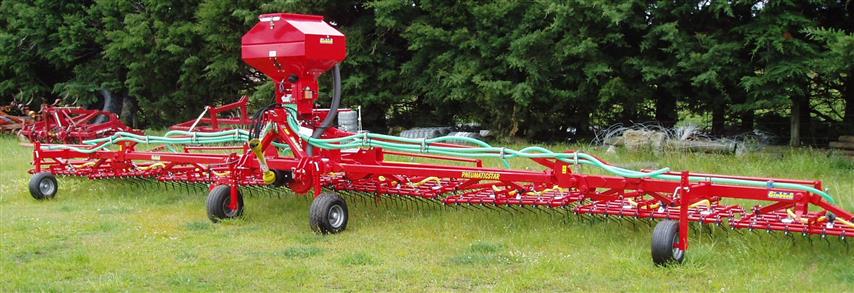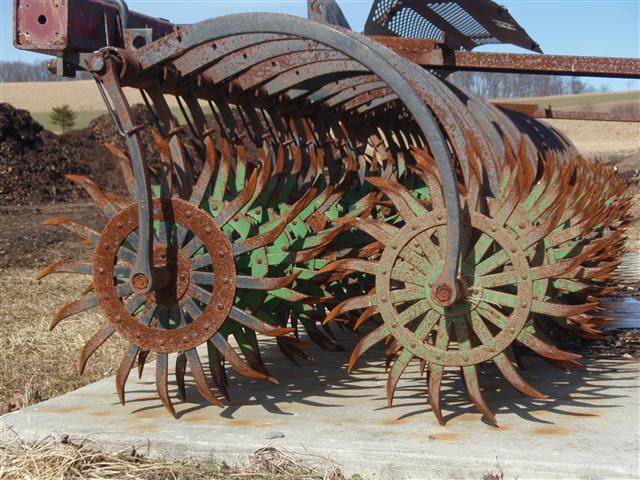It is not often that a truly new type of machine appears in agriculture, most gear is just an evolution (and a considerable increase in size), of machinery that has been in use since the mechanisation of agriculture started with Jethro Tull’s seed drill in the early 1700s. However, every once in a while an truly innovative machine is born, often in a farmers mind, frustrated with a problem on their farm, necessity being the mother of invention and all that.
I think that the CombCut® is one of those truly novel implements. It is a weeder designed to selectively cut weeds from within broad acre crops with thin upright growth habits such as cereals and pasture. At its heart is a row of dagger shaped knives, with a layout reminiscent of the blades on a sickle bar mower. Unlike the mower, there are adjustable gaps between the knives that are sufficiently big to allow the crop to pass through, but are sufficiently small to cut off thicker weeds such as fat hen (Chenopodium album), charlock (Sinapis arvensis) and thistles (family Asteraceae). The cutting effect is also partly determined by tractor speed and also hydraulically driven rotating brushes, a bit like a header reel, that sweep the crop and the weed through the knives, and which also ensure that the cut weeds are ejected out the back of the machine so they don’t clog it up.
A range of photos and videos can be found on the manufactures website, and a search of Youtube.
How effective is CombCut?
Fully evaluating a novel piece of machinery is difficult until a broad range of research and farmer experience builds up. However, a number of initial observations can be made.
First, and like pretty much like every other form of non-chemical weeding, CombCut is no cure-all or a complete substitute for herbicides. Its primary mode of action is to tip the competitive balance between crops and weeds in favour of the crop, by removing a sizeable portion of the aerial part of the weeds, so the crop then overtops the weeds and accelerates past them, thus increasing yield. In some independent research by the Swedish University of Agricultural Sciences in fields with high weed infestation a 68-89% reduction of above-ground weed dry matter and 66-79% reduction of weed root dry weight with a 76-94% higher grain yield have been reported. Clearly, such spectacular results wont occur where weed pressure is much lower, but it does illustrate what the machine is capable of. It also illustrates that CombCut does not normally kill weeds outright, it ‘de-heads’ them, which means they can, and mostly do, regrow, but with the balance now tipped in the crops favour, their regrowth is limited, at least in competitive crops.
The second effect is minimising weed seed rain, i.e., the return of viable weed seeds to the weed seed bank in the soil. For the therophytes, i.e., weeds that originate as seed rather than vegetatively propagated weeds, and especially annual weeds, minimising the weed seed rain can be a very effective means of reducing future weed populations, and in most cases, weed seed rain management is an essential component of any effective non-chemical weed management strategy (and some chemical ones as well). This is the origin of that old farming adage, “one years seeding; seven years weeding”. However, while the CombCut can be used later in the crop life to cut the flowers and immature seed heads from weeds to prevent seeding, that is probably not the best approach, because cutting the weeds early in the crop’s life will often result in the weeds being out competed to the point they shed fewer seeds than if they are de-flowered late in the day. In addition, if the weeds can grow to sufficient size within the crop to be able to produce a large seed rain, then they will also of knocked yield back significantly. Therefore, CombCut should not primarily be thought of as a curative or ‘get out of jail’ option for when a crop is already infested with large weeds, rather, it should be viewed as a preventative tool primarily used at earlier crop and weed growth stages.
Practicalities.
Looking at the practicalities of the machine, it is light weight for its operating width (partly due to it not being soil engaging, so high strength (and therefore weight) is not required), it requires only a small amount of power to drive the hydraulically powered rotating brushes, so a small tractor can lift and power it. It can be both front and rear mounted and can be used at high speeds (which often increase the cutting effect) so combined with widths up to 8 meters, it has good work rates. Having said that, setting the machine up appears to require quite a bit of fiddling for a given crop and weed combination, i.e., getting the knife gap just right, the knife height correct, along with working out the optimum forward and brush speed, so it effectively cuts the weeds but not the crop. It is therefore clear that its not a ‘set-and-forget’ type of machine.
A new tool for the weed control toolbox
The current tools for arable crops and pasture include the tried and tested spring tine harrows and less common rotary spoon weeder. These are only effective against weedlings (cotyledons to four true leaves) so they are generally only used in a narrow time window both sides of crop emergence, because if they are used later, the weeds are often too big to be affected and the crop may be sufficiently big to interfere with the action of the weeders and/or be damaged. Harrows and spoon weeders also need hot dry conditions to have the best effect, and if the soil is really wet, they wont work at all.


The other tool for weed control in arable crops is the interrow hoe, but this requires the whole production system to be designed for hoeing, such as having wide rows, standardised machinery widths, specific wheel spacings etc., so its not an approach that can just be used as an afterthought. While interrow hoes can be exceptionally effective at killing weeds in the interrow, they can be used long into the life of the crop, and they can still do a half decent job even in wet conditions, by their nature, they have limited or no effect on intrarow (within the row) weeds.

In comparison, CombCut is a ‘contiguous weeder’ (i.e., covers the whole ground, not just the interrow) so can deal to intrarow as well as interrow weeds. It can be used throughout the life of the crop, not just early stages. As it is not soil engaging but rather it cuts weeds off above ground, it is likely to be mostly unaffected by weather conditions and wet soils. I therefore think that CombCut fills an empty and important niche in arable weeding machinery.
First it fits chronologically between the early crop growth stage spring tine harrow and spoon weeders and close-to-harvest, weed seed rain management tools such as the ‘Weed Surfer’ (also see FAR Arable Extra, Issue 98, Non-chemical weed management -harvest and the weed seedbank [1]). Also where these early stage weeders fail, e.g., due to wet weather conditions, CombCut provides a useful backup strategy / plan B where currently there are no options but to hope for the best or in bad situations, turn the crop in and start again. Secondly CombCut complements non-contiguous interrow hoes by providing a means of controlling intrarow weeds that would otherwise escape control.
CombCut therefore offers farmers not only a novel piece of machinery, but one that fills a significant gap in the arable and pasture weeding machinery toolbox, particularly for farmers that are using spring tine harrows or spoon weeders. On arable farms dominated by broadleaf weeds, I could even see the CombCut become the most valuable weeding tool.
So, it is pretty rare for a truly novel piece of farm machinery to come along, and even rarer for such an implement to fill a major gap in the machinery spectrum. I’m therefore going to stick my neck out and say that providing the potential fiddlyness of setting the machine up is not too problematic, that CombCut will become an important component of the non-chemical, arable, weed management arsenal. It may therefore even live up to its inventors hype!
References
1. Merfield, C. N. (2013). Non-chemical weed management – harvest and the weed seedbank. Christchurch: Foundation for Arable Research (FAR). https://merfield.com/research/2013/X98_Non-chem_weed_mgmt_-_weed_seed_rain.pdf
